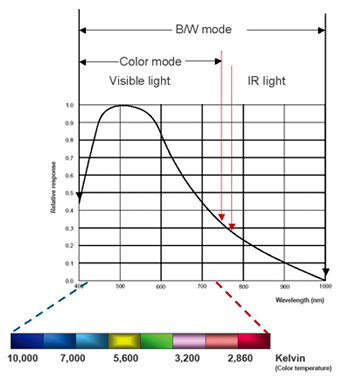
Infrared (IR) cut-off filters are used with colour CCD or CMOS cameras to produce accurate colour images. An IR cut-off filter blocks the transmission of the infrared light while passing the visible light. This can be done with two optical techniques: absorption or reflection.
Absorptive filters are made with special optical glass that absorbs near infrared radiation. Reflection type filters are short-pass interference filters that reflect infrared light with high efficiency.
The absorptive filters are normally used for CCD cameras while the reflective IR filters are used for CMOS cameras.
As modern CCTV cameras and webcams all have a wide visible spectrum, they can all see IR light to some degree. This must be blocked to allow correct reproduction of colour from the camera, but of course it must not be blocked to allow the camera to see IR light for night vision.
Near-infrared light, which spans from 700 nanometers (nm) up to about 1000 nm, is beyond what the human eye can see, but most camera sensors can detect it and make use of it. During the day, a day and night camera uses an IR-cut filter.
IR light is filtered out so that it does not distort the colours of images as the human eye sees them. When the camera is in night (black and white) mode, the IR-cut filter is removed, allowing the camera's light sensitivity to reach down to 0.001 lux or lower.
Day and night cameras are useful in environments that restrict the use of artificial light. They include low-light video surveillance situations, covert surveillance and discreet applications, for example, in a traffic surveillance situation where bright lights would disturb drivers at night.
An IR illuminator that provides near-infrared light can also be used in conjunction with a day and night camera to further enhance the camera's ability to produce high-quality video in low light or night time conditions.

Purpose of IR Filter in Colour Cameras
As already mentioned, the colour spectrum seen by the human eye is quite limited compared to the spectrum seen by a CCD camera. Especially, in the near infrared region of the spectrum the difference in sensitivity is significant.
This is important to know since many light sources, including the sun, emit infrared light. A CCD colour camera in daylight without an IR-cut filter will therefore see a significant amount of infrared light resulting in strange colours. This is particularly noticeable with natural green colours. If a camera without an IR filter is used in an indoor environment then generally the colour reproduction would be reasonably OK. If the same camera is then fitted outside in bright daylight then there is a marked difference in colour reproduction. Browns and reds are relatively unchanged but green and in particular natural green e.g. grass and leaves can appear almost as a silver colour. The resolution is still there but the colour is washed out or different to that expected.
The IR response of a camera for night vision would be badly affected if the IR Cut filter were left in place during low light conditions too. How can a camera be IR sensitive if it has an IR cut filter in the way to block it?
Consequently in order to get the best of both day and night vision with a single camera, mechanical IR cut filters can be automatically switched in and out of the cameras view to allow accurate colour reproduction during the day plus good low light IR response during darkness. This switching is usually accomplished by a light sensor system within the camera.
A mechanical IR cut filter does add to the cost of the camera, so often cameras are used without the filter and are perfectly ok to use in many areas for day night modes, e.g. as internal cameras, or external cameras where the colour reproduction accuracy is not as important as it is to have a good overall picture with good night time performance.
